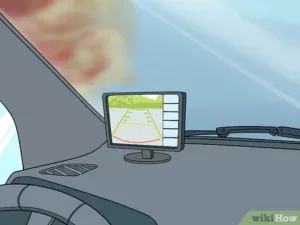Driving is usually fun for some people, while for others, it could be rigorous. This is why accessories like a rear view camera is now an important feature of a car. But do you know how to use rear view camera while driving? It’s not difficult at all. Just follow the steps outlined in this post. Even if you do not have a rear view camera installed in your vehicle yet, this piece of information might come in handy sometime for you or your loved one.
For you to engage your rear view camera, you will first need to switch on your ignition and then turn on your engine. After this, put your gear in reverse. When this happens, your rear view camera automatically displays. It is important to bear in mind that immediately you turn on your engine, the rear view camera comes on. But because it comes on does not mean it is displaying your rear view.
There is a big difference to that. Your rear view camera will only display the rear of your vehicle once you engage the reverse gear.
In some recent models of vehicles, manufacturers make it possible for you to see your rear view while driving forward. This is not a common feature as it is not even recommended. If you have to drive forward and look backward, you may lose concentration. It requires a lot of discipline for you to take just a glance at the rear view screen while driving forward.
Manufacturers do not even make this viewing automatic for you. You will need to activate the function of turning on your rear view yourself. For safety reasons, we recommend that you use your rear view camera for only reverse driving purpose.
Table of Contents
HOW TO USE YOUR REAR VIEW CAMERA CORRECTLY
As important as a rear view camera is, you will only make the most of it when if you know how to use it properly. Find below is a step by step guide on how to make good use of your rear view camera:
- ü You are most likely to see two lines on the screen. A blue squared line and a yellow one. The blue line is for distance and the yellow line is for trajectory. Its good you start getting used to these lines.
- ü As you turn the steering wheel, you will notice that the lines mentioned above also turn in the corresponding direction of your steering wheel. This will help you when you are trying to park the car.
- ü When you turn the steering wheel, also notice that the yellow lines are in sync with the parking space. Keep your hand steady and make sure you are at par with the yellow line.
- ü The blue squared line will also move in correspondence to the parking space. This will show that you are steering the vehicle in the right direction.
- ü Always remember that the blue lines are for your guidance, however, it might sometimes seem like it is outside the marked lines for parking. This does not mean that your car will make a collision with another. Just trust the blue lines.
- ü When you keep moving backward, in time, you will now notice that the blue squared lines are inside the marked lines for parking.
OVERCOMING CHALLENGES WITH REAR VIEW CAMERA
We have gotten feedback from customers that they sometimes have challenges while using their car rear view camera. Well, this is expected as it is an electronic device that you have to get used to, and that can develop faults unannounced.
However, what you call fault is just something that you can surmount if you really know what to do. So here are some ways to overcome challenges you might encounter with your car rear view camera:
- ü Every rear view camera comes with an instructional manual from the manufacturer. Kindly do well to digest the content of the instructional manual before you start using it. Operational guidelines and procedures differ from one product to another, so make sure that you use the one exclusive to your device.
- ü Always make a habit of cleaning the lens of your rear view camera. Depending on usage, frequency and road conditions, your camera lens might be exposed to dust, dirt, fog, smoke, grime and dirt. If you do not clean the lens regularly, it might affect the clarity and quality of the image being displayed in the car. The poorer the quality of the image, the less you can rely on it for judgment.
- ü If you are having a screen problem, chances are that it is not the monitor’s fault. But you might need to call the attention of a technician to check the wiring of the system and make sure that everything is intact.
- ü In the wiring system of a car rear view camera, there is something known as a brown fuse. This fuse can also affect the quality of your screen image if not fixed properly. Refer to your instructional manual to locate the brown fuse if you are having some screen issues.
REAR VIEW CAMERA DIY
As technical as installing a rear view camera is, do you know you can actually do it by yourself? Yes, it is possible to fix your rear camera with little or no supervision. To do this, just follow the steps below:
- ü Drill a hole in your car bumper where you would like the camera to be. Make sure that the hole is the size of the camera to have unhindered coverage of the rear area.
- ü Fix the camera in the bumper of the vehicle.
- ü Fix the wire that connects the camera to the monitor to the camera. To hide the wire and make the connection look neat, you can run the wire under the vehicle until it gets to the dashboard where you connect the monitor.
- ü You can now connect the wire from the camera to the monitor. Be careful to fix the wire in the right ports.
- ü Power on the system and watch your rear view come on.
SAFETY GUIDELINES
Remember that driving is a skill that you have to keep mastering as often as you can. Once you are the one controlling the steering, you have the responsibility of ensuring safety for lives and property in and around the car. So also, when using rear view cameras, there are some safety measures to strongly consider. These are:
- ü The rear view camera is an electronic device. It can malfunction at any given time. It therefore means it was built to help you but you should still use your eyes very well. You will also need to use your other mirrors when backing up as well.
- ü Always let the blue and yellow lines guide you when doing reverse parking. But don’t get too comfortable.
- ü Don’t become overly reliant on your rear view mirror. In fact, before you can start trusting it, make sure that you have familiarized yourself with its operations. And make sure to keep practicing also, as practice makes permanence.
- ü It is also important you know that the lines being displayed on the rear camera might not necessarily be yellow and blue. It might change in different products, depending on the manufacturer. But remember to just know that one is for distance and the other is for trajectory.
- ü For people who have trucks and trailers, one camera might not be enough to give you full view and control of your rear view. You might need at least two cameras to give you a wider view and control over the blind spots while reversing.
Conclusion
Having a rear view camera while driving in reverse makes it a lot comfortable. But remember it is not a substitute for your eyes. You still need to be vigilant and follow operational guidelines. Do this, and you will have no issues using your rear view camera at all. Cheers!



